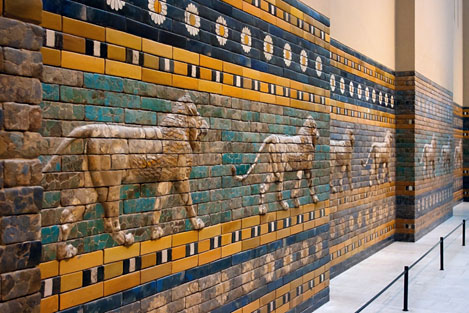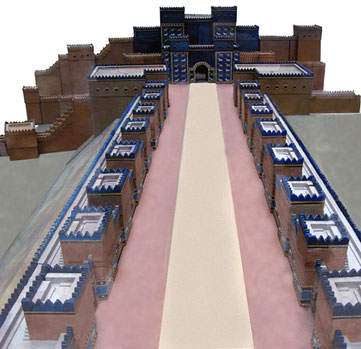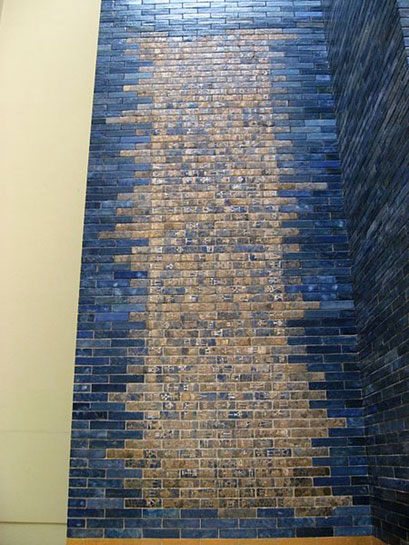The Magnificent Ishtar Gate of Babylon
The Ishtar Gate was the eighth gate of the city of Babylon (in present day Iraq) and was the main entrance into the great city. It was a sight to behold; the gate was covered in lapis lazuli glazed bricks which would have rendered the façade with a jewel-like shine. Alternating rows of bas relief lions, dragons, and aurochs representing powerful deities formed the processional way. The message of course, was that Babylon was protected and defended by the gods, and one would be wise not to challenge it. The magnificent gate, which was dedicated to the Babylonian goddess Ishtar, was once included among the Seven Wonders of the Ancient World until it was replaced by the Lighthouse of Alexandria in the 3 rd century BC. Today, a reconstruction of the Ishtar Gate, using original bricks, is located at the Pergamon Museum in Berlin.
The Babylonians had risen to power in the late 7th century and were heirs of the urban traditions which had long existed in southern Mesopotamia. They eventually ruled an empire as dominant in the Near East as that held by the Assyrians before them. This period is called the Neo-Babylonian Empire because Babylon had also risen to power earlier and became an independent city-state, most famously during the reign of King Hammurabi (1792 – 1750 BC). With the recovery of Babylonian independence under Nabopolassar a new era of architectural activity ensued, and his son Nebuchadnezzar II made Babylon into one of the wonders of the ancient world.
King Nebuchadnezzar II (605 BC-562 BC) ordered the construction of the Ishtar Gate in about 575 BC, and was part of his plan to beautify his empire’s capital. It was under his rule that Babylon became one of the most splendid cities of the ancient world. He ordered the complete reconstruction of the imperial grounds, including rebuilding the Etemenanki ziggurat (the Temple of Marduk) and is also credited with the construction of the Hanging Gardens of Babylon – said to have been built for his homesick wife Amyitis.

A modern recreation of the famous Ishtar Gates of Babylon, showing some of the splendor of the city. Image source .
The Ishtar Gate measured nearly 12 metres in height and had a vast antechamber of the southern side. The roof and doors were made of cedar, while the surrounding bricks were furnished with enameled tiles thought to be of lapis lazuli, a deep blue semi-precious stone that has been prized since antiquity for its intense color.
Through the gatehouse was the Processional Way, a red and yellow brick-paved corridor over half a mile long with walls over 15 metres tall on each side. The walls were adorned with over 120 images of lions, bulls, dragons, and flowers, made from enamelled yellow and brown tiles, as well as inscriptions containing prayers from King Nebuchadnezzar to the chief god Marduk. It was this processional way that led to the temple of Marduk. Every year, statues of deities were paraded through the Ishtar Gate and down the Processional Way for the New Year’s celebration.

Reconstruction of the Processional Way, with sculptural lions, dragons, and bulls lining the path. Source: Wikipedia

City model of the main procession street (Aj-ibur-shapu) towards Ishtar Gate in Babylon. Model at the Pergamon Museum. Source: Wikipedia
During the excavations of Babylon, in the immediate vicinity of the Ishtar Gate, numerous fragments of bricks with remains of white-glazed cuneiform characters were found. The text was restored by comparison with another complete inscription on a lime stone block. It was a dedication by King Nebuchadnezzar II that explained the gate’s construction and purpose:
I, Nebuchadnezzar, King of Babylon, the faithful prince appointed by the will of Marduk, the highest of princely princes, beloved of Nabu, of prudent counsel, who has learned to embrace wisdom, who fathomed their divine being and reveres their majesty, the untiring governor, who always takes to heart the care of the cult of Esagila and Ezida and is constantly concerned with the well-being of Babylon and Borsippa, the wise, the humble, the caretaker of Esagila and Ezida, the firstborn son of Nabopolassar, the King of Babylon.
Both gate entrances of Imgur-Ellil and Nemetti-Ellil following the filling of the street from Babylon had become increasingly lower.
Therefore, I pulled down these gates and laid their foundations at the water table with asphalt and bricks and had them made of bricks with blue stone on which wonderful bulls and dragons were depicted.
I covered their roofs by laying majestic cedars length-wise over them. I hung doors of cedar adorned with bronze at all the gate openings.
I placed wild bulls and ferocious dragons in the gateways and thus adorned them with luxurious splendor so that people might gaze on them in wonder.
I let the temple of Esiskursiskur (the highest festival house of Marduk, the Lord of the Gods a place of joy and celebration for the major and minor gods) be built firm like a mountain in the precinct of Babylon of asphalt and fired bricks.

Building inscription of King Nebuchadnezzar II. Source: Wikipedia
The legendary Ishtar Gate was found to be a historical reality when it was discovered and subsequently excavated between 1902 to 1914 AD by Robert Koldewey, a German architect and archaeologist made famous for his in-depth excavation of the ancient city of Babylon.
Related Post
The entire tomb is filled with signs and symbols that mention Queen Nefertiti and after some time passed and linguistic experts managed to decipher the stories told here, the team was baffled.
The mystery of the Solar Temple of Abu Gurab and its “Star Gate” comes to light
Thuya, the mother of Queen Tiye, left a monumental legacy by becoming the grandmother of Akhenaten and Tutankhamun.
The oldest traditions lead us to believe that blacks were the first inhabitants of Mexico.
The REAL face of King Tut: The pharaoh had feminine hips, clubfoot, and protruding teeth according to the ‘virtual autopsy,’ which also revealed that his parents were brother and sister.
The “oldest gold of humanity” was found in the Varna necropolis, on the Bulgarian Black Sea coast